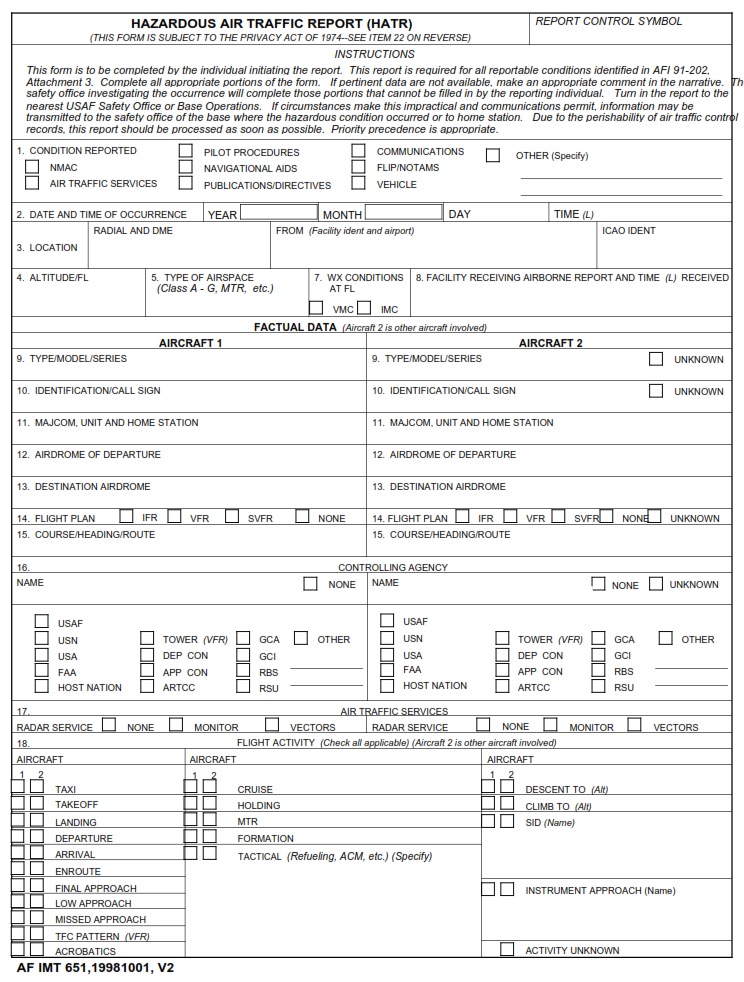AF-FORMS.COM – AF Form 651 – Hazardous Air Traffic Report (HATR) – Have you ever wondered what pilots do when they encounter hazardous air traffic? It’s a question that piques the curiosity of both aviation enthusiasts and those concerned about safety in the skies. The answer lies within the AF Form 651 – Hazardous Air Traffic Report (HATR), a vital tool used by military pilots to document and report any encounters with potentially dangerous airborne situations. This form not only serves as a means of recording these incidents, but also plays a crucial role in shaping air traffic management and safety protocols. In this article, we’ll delve into the significance of the AF Form 651, exploring its purpose, elements, and impact on aviation safety. Join us as we uncover the essential role this form plays in keeping our skies safe for all who take to the air.
Download AF Form 651 – Hazardous Air Traffic Report (HATR)
| Form Number | AF Form 651 |
| Form Title | Hazardous Air Traffic Report (HATR) |
| Edition Date | 10/1/1998 |
| File Size | 45 KB |
AF-Form-651-Hazardous-Air-Traffic-Report-HATR.pdf (70 downloads )
What is an AF Form 651?
The AF Form 651, also known as the Hazardous Air Traffic Report (HATR), is a crucial tool used by military and civilian personnel to report hazardous air traffic incidents. This form serves as a means for individuals to document and communicate unsafe aerial encounters, such as near misses or unauthorized airspace penetrations. These reports are instrumental in identifying potential hazards and implementing preventive measures to ensure air safety.
One key aspect of the AF Form 651 is its role in promoting transparency and accountability within the aviation community. By encouraging individuals to promptly report dangerous airborne incidents, this form facilitates a culture of shared responsibility for ensuring the safety of both military and civilian airspace. Furthermore, the data collected from these reports aids in the analysis of trends and patterns, enabling authorities to proactively address potential risks and enhance overall aviation security.
In essence, the AF Form 651 represents more than just a bureaucratic requirement; it signifies a commitment to fostering a culture of safety and vigilance within the aerospace industry. It provides individuals with a platform to contribute firsthand accounts that can ultimately shape policies and procedures aimed at mitigating hazards in air traffic operations. As such, understanding the significance of this form goes beyond mere paperwork—it underscores an unwavering dedication to preserving safe skies for all.
Where Can I Find an AF Form 651?
If you’re in need of an AF Form 651, also known as the Hazardous Air Traffic Report (HATR), you can typically find it through official military channels. One primary source for the form is the U.S. Air Force’s official website, which provides access to a range of required forms and documents for service members. Additionally, local base support offices or personnel at your installation may also be able to provide you with a copy of the AF Form 651 if needed.
Moreover, it’s crucial to ensure that you are using the most current version of the form, as updates and revisions may occur over time. Keeping abreast of any changes in formatting or content is essential for maintaining compliance with safety reporting requirements within the military aviation community.
By staying informed about where to obtain an AF Form 651 and being diligent about accessing up-to-date versions, service members can contribute to a safer and more efficient air traffic environment while fulfilling their responsibilities to report hazardous conditions or incidents.
AF Form 651 – Hazardous Air Traffic Report (HATR)
The AF Form 651, also known as the Hazardous Air Traffic Report (HATR), serves as a crucial tool in ensuring the safety and security of air traffic operations. This form allows pilots and air traffic controllers to report any hazardous incidents or conditions that could jeopardize flight safety, such as near-miss encounters or unauthorized airspace intrusions. By documenting these occurrences, aviation authorities can analyze trends and patterns to implement proactive measures for mitigating risks and preventing future incidents.
One intriguing aspect of the AF Form 651 is its role in fostering a culture of transparency and accountability within the aviation community. Pilots are encouraged to submit detailed reports of hazardous events, allowing for thorough investigations that can lead to substantial improvements in safety protocols. Furthermore, this form facilitates information sharing among stakeholders, leading to collective learning and enhanced situational awareness across the industry. Ultimately, the HATR plays a pivotal role in promoting a collaborative approach to ensuring safe skies for all aviation enthusiasts.
In addition to its immediate safety benefits, the data collected through AF Form 651 reports also contributes to broader initiatives aimed at enhancing air traffic management systems. By leveraging these insights, governing bodies can identify systemic issues and implement targeted interventions to optimize airspace utilization and streamline operational efficiencies. This strategic use of HATR data underscores its significance not only in safeguarding individual flights but also in shaping the future landscape of aerospace technology and regulation.

